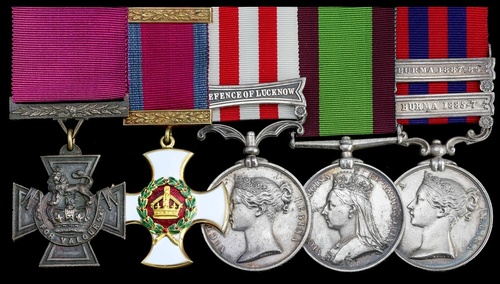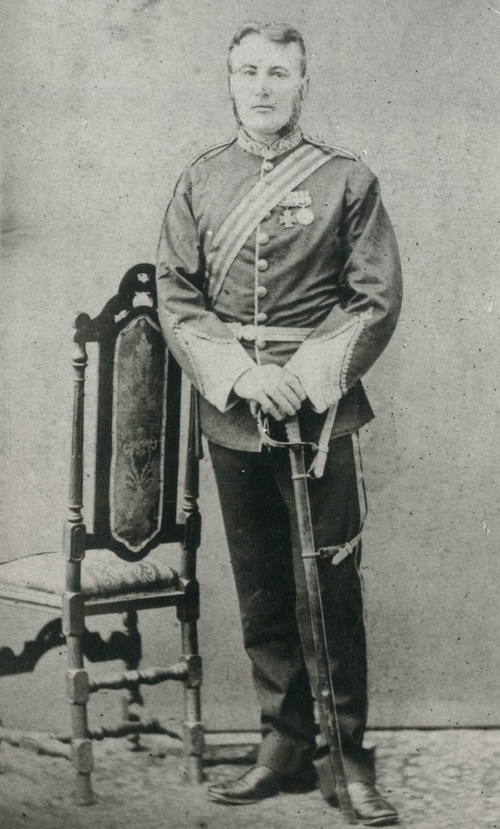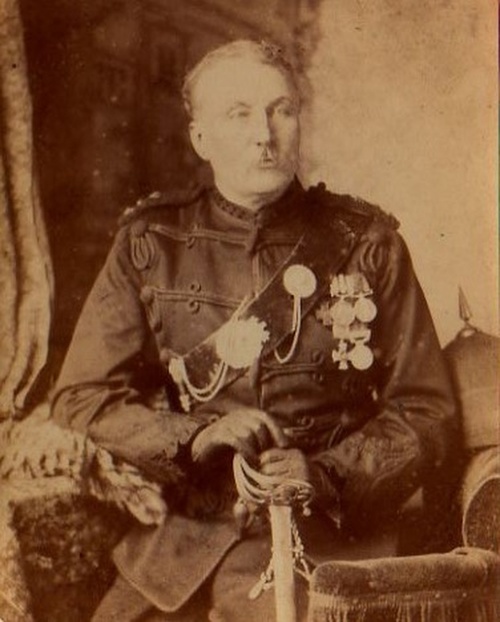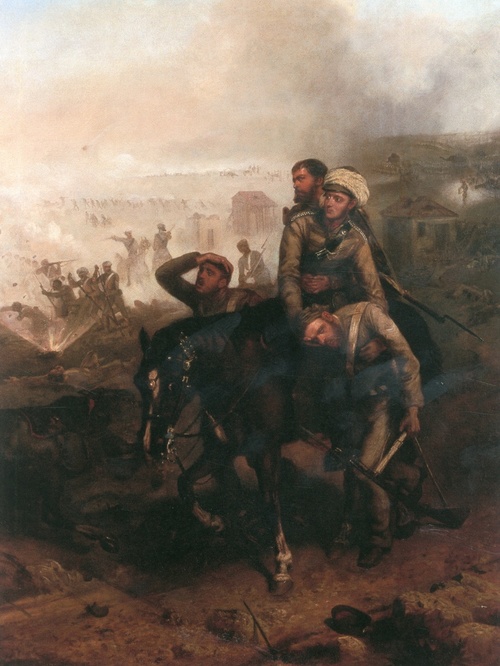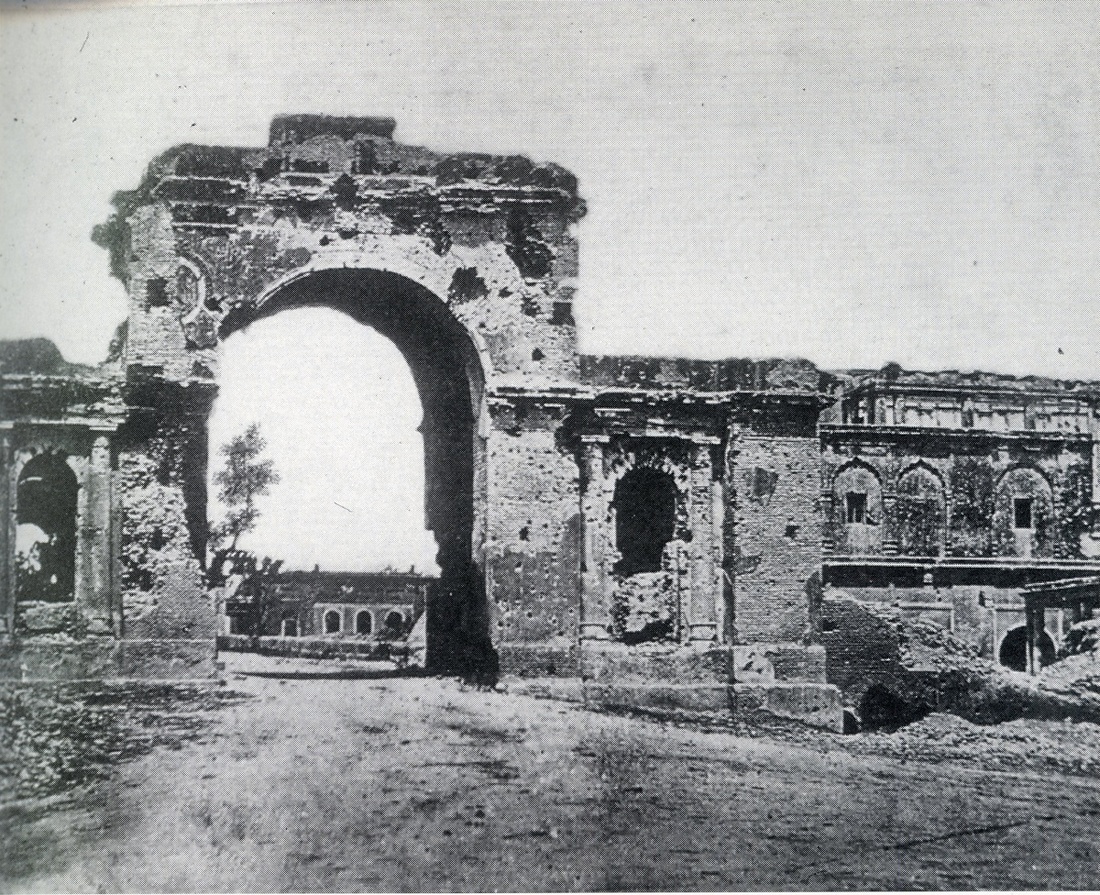Auction: 18001 - Orders, Decorations and Medals
Lot: 550
THE UNIQUE V.C., D.S.O. GROUP AWARDED TO COLONEL WILLIAM GEORGE CUBITT, INDIAN ARMY (1835-1903): 'A HERO OF LUCKNOW'
Sold by Order of a Direct Descendant
'… I wish I could Crown you with a wreath of laurels for the proud deeds that you
have done at Lucknow… I must declare in the face of the world that it was one of the noblest actions that was done by any officer at Lucknow… '
When Lieutenant William Cubitt received the letter from which the above extract is taken, he was convalescent in England, having been invalided home in 1858 after the second relief of Lucknow. The undated letter was written to him by 3256 Corporal James Kirby, 32nd (Cornwall) Regiment of Foot (Light Infantry), one of the three men whose lives Cubitt had saved in the disastrous action at Chinhut on 30 June 1857.
The unique Indian Mutiny V.C., Burma 1886 operations gold D.S.O. group of five awarded to awarded to Lieutenant-Colonel W. G. Cubitt, Indian Army
A Lieutenant in the 13th Bengal Light Infantry at the outbreak of the 'Great Mutiny', he actually won his V.C. as a member of the hastily raised Volunteer Cavalry in the famous action fought at Chinhut, outside Lucknow, on 30 June 1857: on that costly occasion he rescued three wounded soldiers of the 32nd Regiment from certain death, a feat subsequently - and splendidly - portrayed on canvas by the artist Louis Desanges
During the siege of the Residency, he served with equal distinction under Lieutenant Robert Aitken as part the Baillie Guard 'garrison' and was severely wounded on 25 September 1857 - just one of several close calls experienced by him during the siege
Having then risen to the rank of Colonel and nearly died of blood poisoning in the Second Afghan War in 1880, Cubitt added a gold D.S.O. to his accolades for his gallant leadership of the 43rd Goorkha Light Infantry in the Burma operations in 1886, when he took possession of the Ruby Mines
By popular family account the Colonel had a very short fuse - some say he had the worst temper known in the entire Indian Army - but he is otherwise described as being very modest and universally well-liked, especially for his generosity and gallantry
In one of those strange coincidences known to soldiering families, Cubitt's nephew and brother-in-law were also winners of the V.C.
(a)
Victoria Cross, the reverse of the suspension bar officially inscribed 'Lieut. Willm. G. Cubitt 13th Bengal N.I.' and the reverse of the Cross '30th June 1857.'
(b)
Distinguished Service Order, V.R., gold and enamel
(c)
Indian Mutiny 1857-59, 1 clasp, Defence of Lucknow (Lieut. W. J. Cubitt, 13th Regt. N.I), note initials
(d)
Afghanistan 1878-80, no clasp (Lt. Col: W. G. Cubitt, V.C. 16th Ben: N:I:)
(e)
India General Service 1854-95, 2 clasps, Burma 1885-7, Burma 1887-89 (Colonel W. G. Cubitt. V.C. 43d. Bengal Infy.), traces of old lacquer to reverse of V.C., the last with official corrections and second clasp loose upon riband, the campaign medals with contact marks, thus nearly very fine and better, the V.C. and D.S.O. good very fine (5)
V.C. London Gazette 21 June 1859:
'For having on the retreat from Chinhut, on the 30th of June, 1857, saved the lives of three men of the 32nd Regiment, at the risk of his own.'
D.S.O. London Gazette 27 November 1887.
William George Cubitt was the scion of a Norfolk landed family - Cubitt of Catfield Hall - that had produced numerous soldiers in the previous generation. His father was a soldier, as were three of his five uncles; one of his aunts was married to a soldier; one of his cousins was killed in action as a subaltern with the 49th Bengal Native Infantry at Multan in the Punjab in September 1848. Given his inheritance, Cubitt seemed destined to be a soldier; it was either that or the Church.
Early days
He was born in Calcutta on 19 October 1835, the son of Captain William Cubitt, 18th Bengal Native Infantry, and his wife Harriet, who had married in Calcutta in February 1834. His father had become a cadet in the East India Company's Bengal army at the age of fifteen in 1805 and arrived in India the following year, seeing active service in the Nepal War of 1814-16 and in the First Burma War a decade later. At the time of his marriage and the birth of his first child, Captain Cubitt was Assistant Secretary to the Bengal Government Military Department in Calcutta. Promoted Major in 1839, he died in the following year - before his son's fifth birthday. His widow and children returned to England following his death and in 1843, Harriet Cubitt remarried, to William Archer Shee. His step-father, eldest son of the portraitist Sir Martin Archer Shee, became a significant figure in the life of William George Cubitt.
William appears to have been educated by private tutors, as well as attending the school run by The Reverend John Buckland at Laleham, near Chertsey in Surrey; he was also instructed in religious education by the chaplain to the British residents in Bonn. In June 1853, his mother - then resident in Mannheim - applied on his behalf for a cadetship in the Bengal Native Infantry and secured his nomination for that cadetship from the Chairman of the Court of Directors of the East India Company, William Butterworth Bayley. Following his examination for a commission, which he passed, William became an Ensign in the 13th Bengal Native Infantry with effect from 26 July 1853 and set off for India. For the next four years, he learned his trade as a subaltern. He was promoted Lieutenant on 23 November 1856, after having seen active service in the suppression of the Santhall rebellion in Jharkand, eastern Bengal, late in 1855.
Mutiny
When the Indian Mutiny erupted, at the beginning of May 1857, William's regiment was one of those forming the garrison of Lucknow, capital of the state of Oudh. Far from being a co-ordinated and planned insurrection, the Mutiny rapidly spread outward from its beginnings among the soldiers of several regiments of Bengal native cavalry and infantry of the Meerut garrison. Warning of the Mutiny gave the garrison at Lucknow some time to prepare for the defence of part of the city - initially a 60-acre compound centred upon the Residency of the Chief Commissioner for Oudh, Sir Henry Lawrence, and a dilapidated fort, the Macchi Bhawan.
By the end of May, all Oudh was in open rebellion: Delhi was in the hands of mutinous soldiers of the Bengal army, a small British garrison at Cawnpore was besieged and British outposts elsewhere in Oudh had been fallen to mutineers; the murder of British soldiers and civilians, of all ranks and ages and both sexes, was widespread. Receipt of regular reports of the mutineers' activities and progress provided Lawrence and his military subordinates with time to create a rudimentary defensive perimeter surrounding the Residency and adjacent buildings. When some of the Lucknow garrison mutinied at the end of May, Lawrence's loyal sepoys and British troops expelled the mutinous units, pursuing, capturing and summarily executing a great many. When, late in June, Lawrence heard that the garrison at Cawnpore was on the verge of surrender, he knew that it would be Lucknow's turn next and so preparations for its defence were increased. During June, the garrison had been reorganised, with any elements whose loyalty was questionable being expelled and with the Sikhs redeployed into Sikh companies. William's regiment, the 13th Native Infantry, was one of the few such units to remain loyal; it was to that loyalty on the part of a few 'sepoy' regiments that the successful defence of Lucknow was largely attributable.
Although Lawrence occupied a civilian administrative post at Lucknow in 1857, he was a serving soldier and had been all his adult life - having seen more than twenty years' active service from the First Burma War through the First Afghan War to both Sikh Wars. In conducting the defence of Lucknow, Lawrence had to weigh military considerations of attack versus defence against logistical ones that included the protection of British civilians and the conservations of all supplies, while taking into account unknown factors such as how soon he could expect his garrison to be relieved. He was also dependent upon intelligence that was often faulty - an example of which was the size and composition of the rebel force that was reported to be advancing on Lucknow from the east on 29 June.
Disaster at Chinhut
Acting on the 'strike first' principle - and assured by the more fire-eating of his civilian colleagues that the rebel force was small in number - Lawrence decided to conduct a reconnaissance in strength against the mutineers approaching Lucknow from the village of Chinhut. He took that action while being somewhat out of touch with the realities of command in the field; he was also ill-informed and goaded into activity by his Director of Intelligence, Martin Gubbins. Without realising it until too late, Lawrence committed a small force from the garrison to action against a mutineer brigade ten times its size. That error, explicable by the faulty intelligence he was being fed, was exacerbated by the failure to coordinate the military and supply side of the small garrison force. The result was predictable but the ensuing disaster was marked by individual acts of gallantry, among which was that of William Cubitt.
Intended to sally from the garrison before dawn on the morning of 30 June (an extremely hot time of the year and one in which the monsoon was late), the advance from Lucknow was delayed by the late arrival of one of its contingents. The troops were unbreakfasted and sweltering as they set off towards Chinhut; the advance was slow and hampered by the ponderous movement of elephants drawing an eight-inch howitzer along the narrow causeway. After two hours, the garrison force had barely covered the same number of miles, without any sight of the mutineers, so Lawrence ordered a halt for breakfast. While camp-fires were being lit and appetites sharpened among the men, Lawrence and his staff rode forward towards Chinhut but found no sign of any mutineers. Convinced that the mutineers posed no immediate threat to Lucknow, Lawrence ordered his column to return to the city; that order was almost immediately countermanded as Lawrence was talked into advancing by younger, over-optimistic members of his staff who lacked both his caution and his responsibilities. So, the kettles were upset on the fires, the men resumed belts and - still unbreakfasted (and no doubt grumbling as only the British soldier can when being 'messed about') - resumed the march towards Chinhut. Big mistake: they were walking into a trap.
It was now nearing the hottest time of day and the British soldiers began to suffer from heat, hunger and shortage of water. The column moved slowly towards the village of Chinhut and soon came under well-directed artillery fire, the round-shot whistling in from guns situated about a mile in front and, ricocheting among the artillery train, rapidly caused casualties among some Indian bearers and artillery drivers. Observing the effects of a direct hit from round-shot did nothing to improve the morale of the non-combatants among the Indian troops and so Lawrence's logistics tail began to weaken as the inevitable desertions began. In the face of the mutineers' artillery, Lawrence shook his column out into line and deployed forward, either side of the road, to attempt to take the mutineer's positions, which appeared to
be based in two villages flanking the road; his guns remained on the road and were soon engaging in effective counter-battery fire.
The loyal Indian soldiers were initially successful in storming the village on the right of the road but H.M's 32nd Foot - hungry, hot, thirsty and already exhausted - were unable to deploy sufficiently rapidly to their front to take the other village, Ismaelganj. As the advance of the 32nd slowed, the officers began to fall. Many of the 32nd attempted to return fire but some found that their muskets - loaded since before dawn and so with the charges in the breeches dampened by the humidity - refused to function and so the soldiers had, under fire, had to draw the charges before their muskets could be reloaded. A sizeable body of mutineers was by that time in possession of Ismaelganj and pinning down the 32nd with accurate musketry: they had, after all, been trained by British officers and N.C.O.s and knew their business.
After about an hour, the artillery duel petered-out, the garrison force briefly encouraged as the mutineers' artillery slackened and then fell silent. The firefight outside Ismaelganj continued, with the 32nd still halted in its advance and suffering continuing casualties from accurate and sustained volleys of mutineer musketry. Any optimism on the part of the British, generated by the end of the artillery duel, was sadly misplaced. The mutineer force, numbering some six thousand or so, was stiffened by a trained core of Bengal native regiments - cavalry and infantry - which was very well led by a mutineer Rissaldar (captain of cavalry), Barkat Ahmed; the reason for the cessation of the mutineer artillery rapidly became obvious - a general advance had been ordered. There are many published eye-witness accounts of this part of the Battle of Chinhut but that of John Lawrence - a civilian serving with a troop of Volunteer Cavalry - is the most oft-quoted, for reasons that will now become apparent:
'After an hour's cannonade, the opposite artillery ceased its fire: in a few minutes rolling volleys of musketry from the village of Ishmaelgunge showed that Jack sepoy was there. The Volunteer Cavalry was ordered to move further to the right, and then, for the first time, I got a view of the plain between Ishmaelgunge and Chinhutt. It was one moving mass of men: regiment after regiment of the insurgents poured steadily towards us, the flanks covered with a foam of skirmishers, the light puffs of smoke from their muskets floating from every ravine and bunch of grass in our front. As to the mass of the troops, they came on in quarter-distance columns, the standards waving in their places, and everything performed as steadily as possible. A field day on parade could not have been better … Our artillery ceased its fire but beyond might be heard the crashing roll of musketry in Ishamaelgunge, where the 32nd, outnumbered by myriads, still maintained a struggle … a bustle in my rear attracted my attention: the rascally gunners were cutting their traces and were galloping away; the elephants for the howitzer gone … A few European gunners, the Volunteer Cavalry, and the 32nd remained; but now the enemy pressed on more closely - he unlimbered his guns and swept us with grape and canister; the deadly mitraille of musketry poured in one leaden shower from the swarming skirmishers. And now the valiant few of the 32nd are beaten near the village and come upon the road; their gallant Colonel (Case) falls dead as he approaches; some of our guns are spiked and abandoned (the howitzer among them), four are limbered, and gun carriages, covered with wounded men, gallop towards Lucknow. The 32nd also retreat; mixed up with them are some of the braves of the 13th Native Infantry - noble fellows, who were seen carrying wounded soldiers to the gun-carriages, abandoning their own wounded comrades on the ground. The Volunteer Cavalry form upon the left of the road; the rest of the handful of England's army is in retreat. A cloud of insurgent cavalry is gathering on the far rear to the left of our retreating column. Do they mean to charge down among those staggering, half-dead heroes, who can scarcely walk along? The red and the blue flags thicken among them; when the tremendous voice of our leader (Captain Radcliffe of the 7th Light Cavalry), is heard, - 'Three's right!' 'Trot!' and we sweep out of the trees, and off the road, and we are within a quarter of a mile of our opponents. ... now two light guns open on us, but the 9-pounder scarce whistled over head when the stentorian 'Charge!' was heard; the notes of our trumpet sounded sharp above the din of the fight, and we rode straight at them; the cowards never bided the shock; they galloped like furies from the spot. Five hundred cavalry and two guns to be hunted by thirty-five sabres; it was a miserable fact … The battle of Chinhutt was done; the line of our retreat was marked by the bodies of the 32nd, their arms, their accoutrements; men were falling untouched by ball; the heat of a June sun was killing more than the enemy. Hard upon our heels they followed; and as we got into the Residency so did the round shot of the pursuing foe whistle in the air… '
Evolution of a V.C.
William Cubitt served with the troop of Volunteer Cavalry at Chinhut, on detachment from his regiment, and so took part in the famous charge described by John Lawrence. As the citation for the award of his Victoria Cross recounted, he was also active in the retreat, collecting, first, Lance-Corporal Kirby, whom he sat behind him on his horse, and, then, two privates of the 32nd, whom he dragged along as they clung to his stirrups. All that while being hotly pursued by the mutineers, who neither gave nor expected quarter: there can be no doubt that Cubitt saved those three soldiers from certain death - and probably a death that would have been bloody and prolonged. Let us return to Corporal Kirby's letter, which provides information about the circumstances of his rescue, and Cubitt's valour, not previously published. It is quoted in its original form:
' … I have no doubt Sir, but you remember saving the lives of three men of Her Majesty's 32nd Regiment. I am one of them, kind Sir, and this Irish man that you wanted to know his name, my name is Kirby, Sir, and the man that you brought in behind you on your horse. The names of the others are Joseph Deolin, 3rd Company 32nd Regiment, but the name of the 3rd man Sir I am sorry to say that I altogether forgot, for as you know I was struck with the gowling sun of the 30th June and for me Sir you know that you rode a gray charger and that you had to get one of the native Cavalry to get me on with your own assistance, the other two men you made them cling to your stirrups … I can call on Colonel E.W.D. Lowe that you took me to Hospital verandah and stoped there until you saw me, carried into the Hospital …'
In making a statement in support of the process to secure the award of the Victoria Cross for Cubitt, from Allahabad on 13 June 1858, Corporal Kirby testified:
' … I solemnly and sincerely believe that Lieutenant Cubitt saved my life and that of the two other men at the risk of his own … '
Three months later, from Chatham Barracks on 17 September 1858, Private Joseph Deolin concurred:
'On the retreat from Chinhut on the 30th June 1857, I sincerely and truly believe that Lieutenant Cubitt of the 13th N.I., then serving with the Volunteer Cavalry, saved my life at the risk of his own by stopping behind under a very heavy fire from the enemy who were close to us by making me hold on by his stirrups and by that means enabled me to reach the Residency.'
As is often the case with reminiscences from the period, we are indebted to Louisa Hadow Jenkins, daughter, wife and sister of Army officers, for background information about how William Cubitt came to be recommended for the award of the Victoria Cross. Mrs. Jenkins accompanied Cubitt from Calcutta to England after the relief of Lucknow. Cubitt was wounded during the siege at least once, the last time severely, and so had been ordered home in 1858 on a well-earned furlough in order to recuperate. Mrs. Jenkins recorded, 'He was quite a lad then, modest and unassuming. He never talked of this deed as anything out of the common.'
However, when Cubitt got home he attended a dinner party in London. Jenkins continues:
' … [and] happened to be near some great man whom he did not know but who, struck by his modest way of recounting experiences (which at that time everyone wanted to know), found out his name and regiment, and Colonel Aitken was asked about him. The result was a V.C., given to him by Queen Victoria's own hands! And Colonel Aitken [Robert Hope Moncrieff Aitken, V.C.] told me that, even if that act of valour had never been performed, he richly deserved his reward for all his acts of self-denial in every way. In the time when rations were short he would surreptitiously make over his share to someone whom he thought required it more.'
Cubitt's 'V.C. file' at The National Archives is silent concerning the identity of the 'great man' but possibly implies that Cubitt's step-father, William Archer Shee, was somehow involved in securing the award on William's behalf. It is implicit from that file that Robert Aitken, V.C., who had commanded the Baillie Guard 'garrison' during the siege of Lucknow and who had been William's immediate commanding officer, had exercised himself in obtaining the necessary supporting documentation from India - which enabled a letter of recommendation from an examining Board of Officers in Calcutta to be sent to the British authorities on 3 March 1859.
The recommendation was passed to Queen Victoria on 15 June 1859, announced in the London Gazette six days later and William was decorated by the Queen at Windsor on 4 January 1860.
Return to India
Cubitt returned to India in 1861, to rejoin his old regiment. In 1857 the loyal remnants of the 13th, 48th and 71st Bengal Native Infantry had been formed into 'The Regiment of Lucknow'. The regiment was renumbered 16th Bengal Native Infantry in 1861; in 1864, it was sub-titled 'The Lucknow Regiment' in honour of its loyal service during the siege.
On 19 May 1863, William was married in St Peter's Church, Fort William, Calcutta. His bride was Charlotte Isabella Hills, sister of James Hills, V.C. of Delhi in 1857 - and, eventually, aunt of Brigadier Lewis Pugh Evans, V.C. The marriage produced five children.
William served as adjutant in his regiment between 1862 and 1867, being promoted Captain on 26 July 1865. He was appointed Brigade Major in Benares in 1867 and became a 'wing officer' in the 16th in 1872, promotion to Major coming on 16 July 1873. Between 1873 and 1874 he was officiating station officer in Dacca; in 1875, he served in the expedition against the Dufflas on the North-East Frontier and was mentioned in despatches. Between 1874 and 1880, he was a 'wing officer', second-in command and officiating as commandant of the 16th, being promoted Lieutenant-Colonel on 26 July 1879.
In early January 1876, William was summoned to Lucknow to attend the Prince of Wales, then on his tour of India. As Dr. Fayrer, who was also in attendance upon the Prince, recorded, the Prince's party toured the area of the siege and the Prince laid the foundation stone of a memorial to those loyal Indian soldiers who had died during the siege. At the ceremony, Fayrer recalled:
'I stood with three other officers - Smith, Cubitt and Birch, the only commissioned officers of the old garrison present - opposite to the Prince, the old sepoy pensioners and others of the garrison drawn up near us. … the survivors were present to him [the Prince] by Cubitt, Birch and myself.'
Further active service - further laurels
Attached to the Bengal Staff Corps from 1879, he served as second-in-command of the 16th (Lucknow) Bengal Native Infantry in 1880, in which capacity he was employed in the Khyber Line Force and commanded the fort at Ali Musjid during the Second Afghan War until May 1880, when he was invalided - and nearly died - as a result of blood poisoning.
On returning to duty in 1881, he was given command of the 43rd (Assam) Bengal Native Infantry - afterwards the 43rd Goorkha Light Infantry - a command that he retained until 1888. He was promoted Colonel on 26 July 1883 and served on the North-East Frontier again, between 1883 and 1884 in operations against the Akkas; he was again mentioned in despatches.
Between 1886 and 1888, he served during the Third Burma War, being created one of the first Companions of the newly instituted Distinguished Service Order in recognition of his services and being again mentioned in despatches (London Gazette 2 September 1887, refers). During the latter operations he occupied the Ruby Mines and was based in the Enjouk Valley for several months.
William retired in 1889 and was placed on the Unemployed Supernumerary List in 1891.
He and his wife retired to England, to live in Camberley, where he died on 25 January 1903. He was buried in the churchyard of St. Peter's Church, Frimley, where a stone cross marks his place of interment. His widow survived him by thirteen years, dying on 4 August 1916 and being buried beside her late husband.
Sold with a portrait photograph and an old copy of Louis Desanges' painting of Cubitt in the process of winning his V.C., as commissioned by the family in 1918, oil on canvas, the reverse with ink inscription, 'Lieut. William George Cubitt, V.C., D.S.O., Indian Mutiny 1857, orig. by Chevalier L. W. Desanges' and 'Copied by Arabella L. Joy, 18 Woodside, Wimbledon, 1918', in gilt frame, with inscribed plaque:
'Lieut. afterwards Colonel W. G. Cubitt, V.C., D.S.O., Returning from Chinhut, Lucknow, 1857 …. '
1362 mm. by 1056 mm., somewhat faded and distressed.
Reference sources:
Primary sources:
The National Archives, WO 32/7330; Decorations and Medals: Victoria Cross (Code 50(M)): Indian Mutiny: Recommendations concerning Lieutenants W. Cubitt and H. Jarrett and Private J. McGovern; supporting evidence 1858.
Secondary sources:
Burke, J. & B., A Genealogical and Heraldic Dictionary of the Landed Gentry of Great Britain (London, 1847), p. 293.
Case, A., Day by Day at Lucknow: a journal of the Siege of Lucknow (London, 1858).
Creagh, G. O'M. & Humphris, E. M., The V.C. and D.S.O. (London, 1924). Vol. I, p. 61.
David, S., The Indian Mutiny, (London, 2002), pp. 222-226.
Edwardes, J. J. & Merivale, H., Life of Sir Henry Lawrence, (London, 1872), Vol. II, pp. 352-369.
Edwardes, M. (ed.), Journal of the Siege of Lucknow… by Maria Germon (London, 1958).
Edwardes, M., A Season in Hell (London, 1973), pp. 40-48.
Fayrer, J., Recollections of my Life (London and Edinburgh, 1900), pp. 155-160 & 364-365.
Fitchett, W. H., The Tale of the Great Mutiny (London, 1902), pp. 156-161.
Forrest, G. W., A History of the Indian Mutiny (London & Edinburgh, 1904), pp. 226-237.
Gubbins, M. R., An Account of the Mutinies in Oudh, and of the Siege of the Lucknow Residency (London, 1858), pp. 180-191.
Hadow Jenkins, L., General Frederick Young: the life story of one of the old brigade in India (London and New York, 1923, pp. 222-229.
Hewitt, J. (ed.), Eye-Witnesses to the Indian Mutiny (London, 1972), pp. 129-135.
Hodson, V. C. P., Officers of the Bengal Army 1758-1834 (London, 1927), Vol. I, pp. 420-421.
Holmes, E. R., Sahib: the British Soldier in India (London, 2005), pp. 328-331.
Holmes, T. R., A History of the Indian Mutiny (London and New York, 1898), pp. 263-267 & 583-584.
Inglis, The Hon. Lady, The Siege of Lucknow: a diary (London, 1892).
Joyce, M., Ordeal at Lucknow (London, 1938), pp. 1-11.
Kaye, J. W., A History of the Sepoy War in India (London, 1876), Vol. III, pp. 501-513.
McLeod Innes, J. J., Sir Henry Lawrence, the Pacificator (London, 1898), pp. 183-193.
McLeod Innes, J. J., Lucknow and Oude in the Mutiny (London, 1895), pp. 97-102.
Malleson, G.B., History of the Indian Mutiny 1857-1858 (London, 1878), Vol. I, pp. 423-429.
Morison, J. L., Lawrence of Lucknow (London, 1934), pp. 301-325.
Rees, L. E. R., A Personal Narrative of the Siege of Lucknow (London, 1858).
Swiney, G. C. (comp & ed.), Historical Records of the 32nd (Cornwall) Light Infantry (London & Devonport, 1893), pp. 179-183 & 267-269.
Tuker, F. (ed.), The Chronicle of Private Henry Metcalfe, H.M. 32nd Regiment of Foot (London, 1953), pp. 26-31.
Wilson, T. F., The Defence of Lucknow; a diary … by a Staff Officer (London, 1858), pp. 38 43.
Wright, C. J. & Anderson, G.M., The Victoria Cross and George Cross; the complete History (York, 2013), pp. 140-141.
Subject to 20% VAT on Buyer’s Premium. For more information please view Terms and Conditions for Buyers.
Sold for
£180,000

